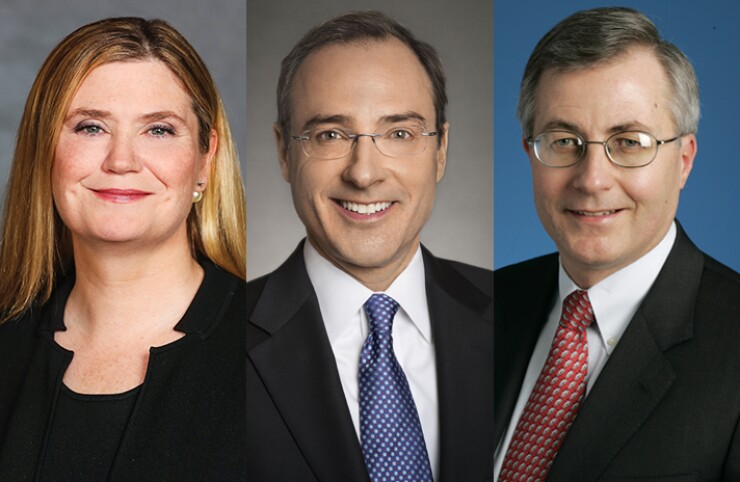If there’s something that policymakers and bankers have in common, it’s their refusal to accept an initial offer when they sense a good opportunity.
Such was the industry’s reaction Friday to the latest moves by bank regulators to ease post-crisis capital rules. During quarterly earnings calls, executives welcomed two separate proposals that, in some cases, would trim the capital cushions that banks have spent the past decade building up.
Still, one of the nation’s most prominent bankers made it clear that, while the proposed changes are a step forward, regulators could go much farther.

JPMorgan Chase Chief Financial Officer Marianne Lake reiterated the company’s previous calls for regulators to overhaul a capital surcharge for global systemically important banks, or G-SIBs. Now that regulators are open to reconsidering other big-bank capital rules, the surcharge should also be on the agenda, she said.
“Stepping right back, if we are fundamentally reconsidering the construct of minimum capital levels, then all of the building blocks should be in play, including the G-SIB surcharge, to ensure they all hang together,” Lake said.
The G-SIB surcharge requires the biggest global banks, including eight U.S. institutions, to hold additional capital — ranging from 1% to 4.5% — on top of regulatory minimums, based on their risk profile. JPMorgan
During a separate call with reporters, Lake said the score is “overindexed” to a bank’s total size, rather than to the risk it poses broader financial system. Thanks to recent economic growth — and, therefore, growth at U.S. banks — the G-SIB surcharge scores are “naturally trending higher,” she said.
In making her case, Lake also noted that JPMorgan Chase, in particular, has successfully implemented post-crisis requirements imposed since the subprime mortgage meltdown.
“The underlying premise for the surcharge — and more particularly U.S. gold-plating — is somewhat unnecessary for a firm that is compliant with all of the post-crisis reform that directly addresses systemic risks, which includes the severity” of the annual stress tests, Lake said.
The reaction comes just days after regulators published two highly anticipated changes to minimum capital thresholds.
The Fed on Tuesday issued a proposal that would change the way it calculates a required capital buffer for banks with more than $50 billion in assets. Under current rules, the buffer is set at 2.5% additional common equity Tier 1 capital than the regulatory minimum for the industry. In total, that means big banks must have a CET1 ratio of at least 7% in order to pass muster with regulators.
The Fed’s proposal, among other changes, would replace the flat, 2.5% buffer with a more dynamic ratio, based on a given bank’s results in the latest round of annual stress tests. The ratio would be comprised of a bank’s CET1 losses under the prior year’s most severe scenario, plus four quarters of planned dividend payments.
Robert Reilly, CFO at PNC Financial, said Friday that the company is still reviewing the proposal. Under the plan, the buffer could “theoretically could be higher” than 2.5%, depending on scenarios that the Fed uses for the annual stress tests, he said.
“The stress capital buffer itself we have to review,” Reilly said, adding that, over the long term, the company aims to have a CET1 ratio of around 8.25%. As of March 31, that figure stood at 9.6%.
Bankers were more welcoming, however, of a separate proposal, issued Wednesday by the Fed and the Office of the Comptroller of the Currency, to change how they calculate the so-called “enhanced supplementary leverage ratio.”
Under the changes proposed this week, the additional 2% charge would be replaced with a separate ratio. Instead of a flat amount, it would be calculated as of the bank’s G-SIB surcharge.
“We would applaud the increased flexibility that it can grant us,” said John Gerspach, chief financial officer at Citigroup. As of March 31, Citi’s supplementary leverage ratio was 6.7%, down from 7.27%.
Gerspach added, however, that the ratio “never really has been something that has impacted our business.”
Lake, too, said she welcomed the proposal, while also acknowledging that the company hasn’t felt “extraordinarily constrained” by the ratio under current rules.
Under the proposal issued Wednesday, JPMorgan’s supplementary leverage ratio would be 4.75%, according to a recent note from Keefe, Bruyette & Woods. That figure stood at 6.5% at the end of the first quarter.
While Lake bristled at the use of the G-SIB surcharge in the new calculation, she nonetheless favored the broader move by regulators to review and, in some cases, pare down capital requirements.
“Overall, we’ve been waiting for these proposals, and we look forward to participating in the comment process,” she said.





